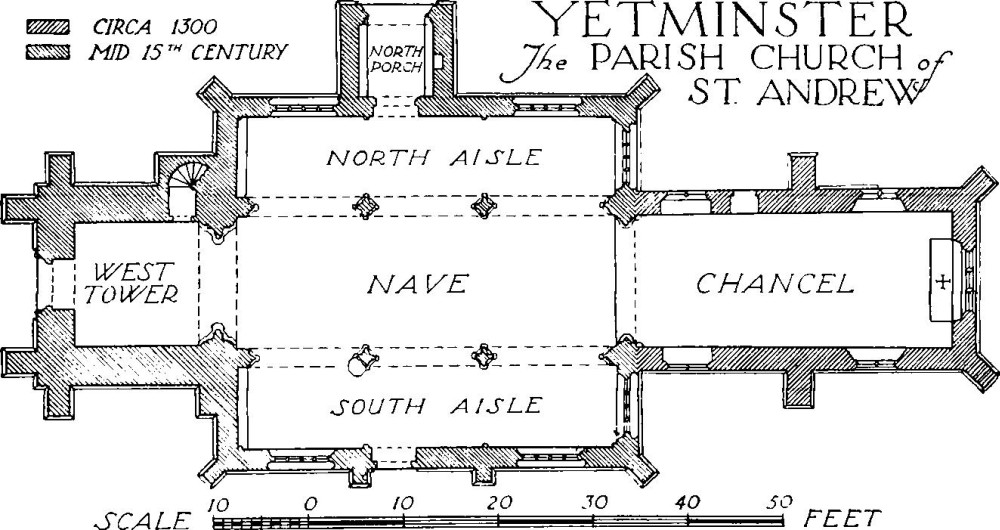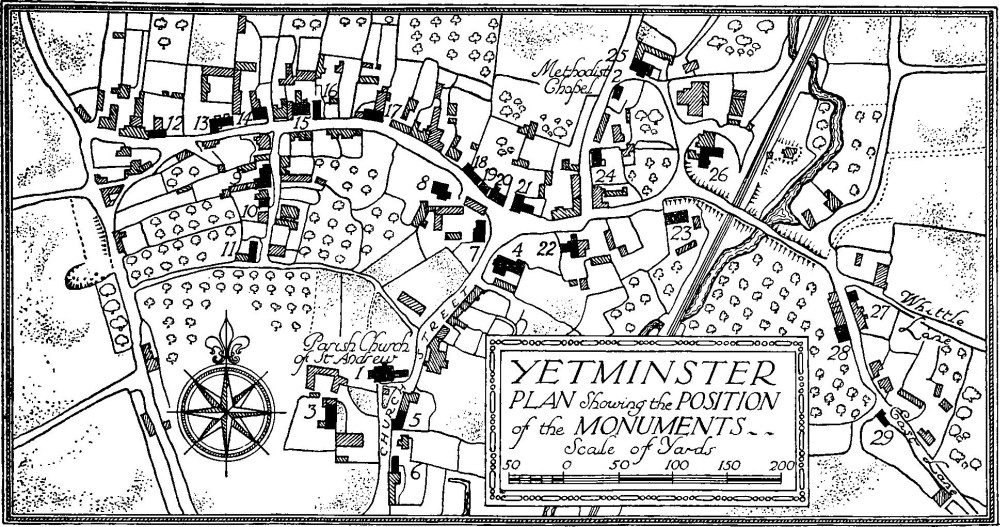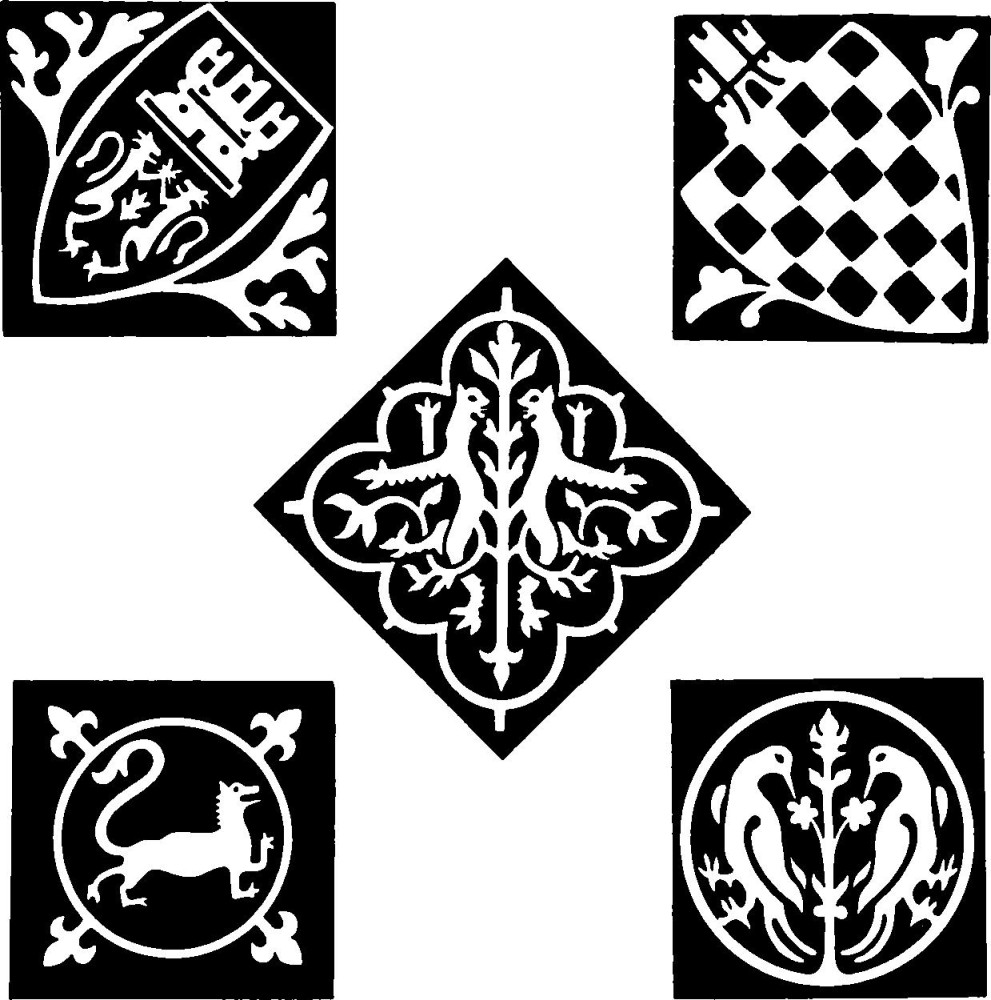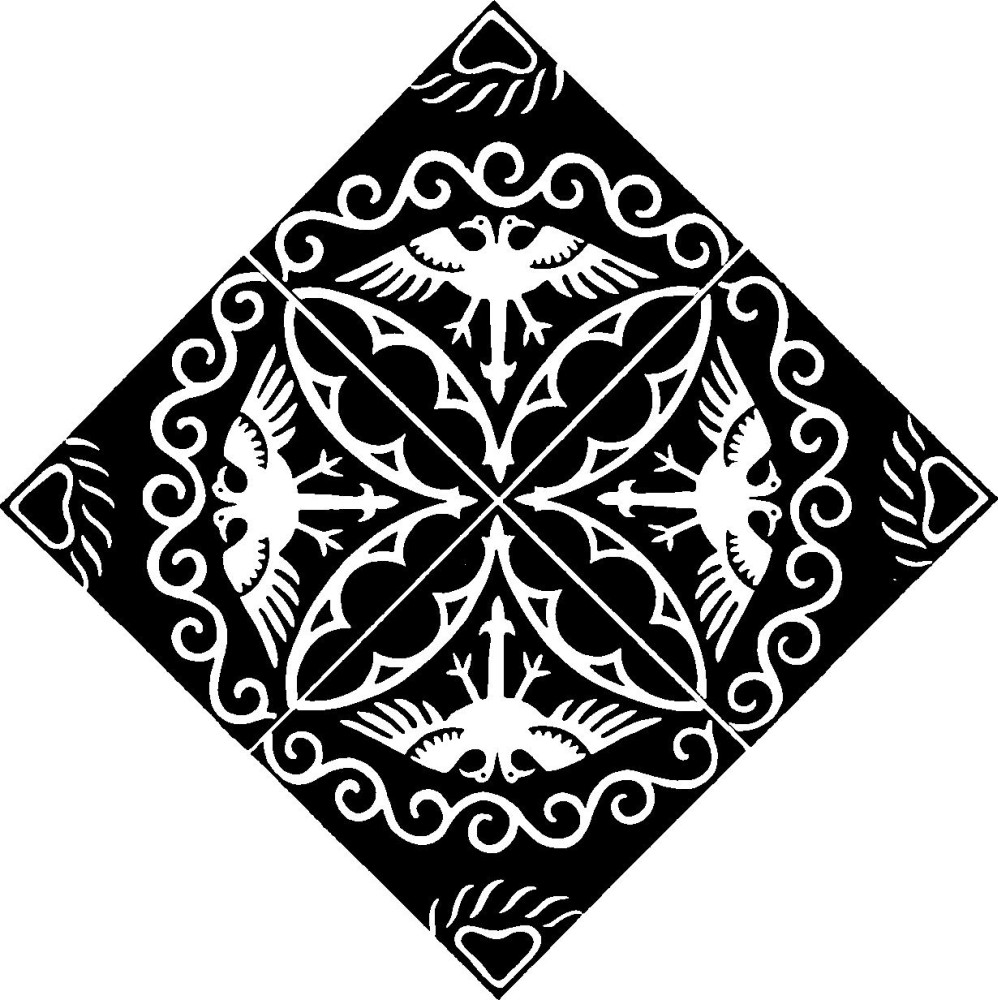An Inventory of the Historical Monuments in Dorset, Volume 1, West. Originally published by Her Majesty's Stationery Office, London, 1952.
This free content was digitised by double rekeying. All rights reserved.
'Yetminster', in An Inventory of the Historical Monuments in Dorset, Volume 1, West, (London, 1952) pp. 270-274. British History Online https://www.british-history.ac.uk/rchme/dorset/vol1/pp270-274 [accessed 25 April 2024]
In this section
100 YETMINSTER (D.b.)
(O.S. 6 in. (a)XI, S.E. (b)XXI, N.E.)
Yetminster is a parish and village 4½ m. S.S.W. of Sherborne. The church is the principal monument.
Ecclesiastical
a(1) Parish Church Of St. Andrew stands at the S. end of the village. The walls are of local rubble with dressings of Ham Hill and other local stone and the roofs are lead-covered. The Chancel was built c. 1300; a consecration is recorded in 1312. About the middle of the 15th century the rest of the church, consisting of the Nave, North and South Aisles, West Tower and North Porch was rebuilt. The church was restored in 1890 and in more recent years.

Yetminster, the Parish Church of St. Andrew
Architectural description—The Chancel (33¼ ft. by 14¼ ft.) has an E. window of three pointed lights, partly of c. 1300 but reset and much restored. In the N. wall are two partly restored windows of c. 1300, each of two lancet-lights; the doorway is of the same period but the head is modern. In the S. wall are two windows uniform with those in the N. wall. The mid 15th-century chancel-arch is two-centred and of two moulded orders, with responds of nearly the same section, moulded bases and capitals carved with paterae and a rose; above the arch are two blocked windows each of one four-centred light.
The Nave (40 ft. by 14 ft.) has mid 15th-century N. and S. arcades of three bays with moulded two-centred arches similar to the chancel-arch; the piers have each four attached shafts, separated by wide hollows and with moulded bases and capitals; the latter have carved paterae or foliage on the N. arcade and small grotesque beasts on the S. including geese hanging a fox; the responds have attached half-piers; the arcades retain remains of blue and red colour in bands.
The North Aisle (8¼ ft. wide) is of mid 15th-century date with an embattled parapet. The E. window is of four trefoiled lights with vertical tracery in a two-centred head with moulded reveals. In the N. wall are two windows uniform with that in the E. wall but the western much restored; the N. doorway has moulded jambs and two-centred head; near the E. end of the wall and high up is a blocked window of one four-centred light.
The South Aisle (8½ ft. wide) is generally similar to the N. aisle but the S. doorway has a square moulded label with returned stops and high up over the eastern window in the S. wall are two blocked windows each of one four-centred light.
The West Tower (13 ft. by 12¾ ft.) is of mid 15th-century date and of three stages with an embattled parapet, pinnacles and gargoyles (Plate 3). The two-centred tower-arch is moulded, the outer and inner members being treated as shafts on the responds, with moulded bases and capitals; there are remains of spiral bands and cheverons in colour. The partly restored W. window is of five cinque-foiled lights with vertical tracery in a two-centred head with moulded reveals and labels; the W. doorway has moulded jambs, two-centred arch and label continued from the top members of the plinth. There is a modern gallery in this stage. The second stage has, in the N. and S. walls a window of one square-headed light. The bell-chamber has, in each wall, a window of two cinque-foiled lights with tracery in a two-centred head with a moulded label and beast-head stops.
The North Porch is embattled; the 15th-century two-centred outer archway is moulded, the inner member being treated as a shaft, on the responds, with moulded capital and base.
The Roof of the nave is of the 15th century, partly restored, of trussed-rafter type and of barrel-form with moulded braces at intervals forming six bays, moulded purlins and bosses at the intersections carved with foliage, a double rose and a horse's head; there are remains of colour including cheverons in black and white. The partly restored 15th-century pent roof of the N. aisle is of three main bays with moulded principals and curved braces springing from attached stone wall-shafts with moulded capitals and bases; each bay has four subdivisions with foliage-bosses at the intersections; the rafters are painted with the crowned initials Ihs in black on a white ground, alternating with white and red stars on discs; the central purlin is painted with cheverons, flowers and spiral bands. The roof of the S. aisle is similar but retains much less colouring; the central boss has a double rose.

Roundel in the Parish Church
Fittings—Bells: six; 2nd probably 1670 and by Thomas Purdue; 3rd, by William Warre, 1595; 4th, 15th-century, Bristol foundry, and inscribed "Ora mente pia pro nobis Virgo Maria"; 6th, by Robert Wiseman, 1608, with roundel bearing the ox of St. Luke. Brackets: In nave—on E. responds of arcades, two moulded brackets with foliage-ornament, 15th-century. In N. aisle—in N.E. angle, moulded bracket on carved half-angel, probably late 14th-century reset. Brass and Indent: Brass: In S. aisle—on S. wall, to John Horsey, 1531, and Elizabeth (Turges), his wife, figures of man in enriched armour and woman with pedimental head-dress, ten scrolls and two shields-of-arms, (a) Horsey quartering Malbank and (b) the same impaling Turges. Indent: In tower—very worn but retaining traces of side standards and canopy, possibly 15th century. Clock: In tower—wrought-iron frame and part of mechanism with brass plate recording the maker and date, Thomas Bartholomew of Sherborne, 1682, and the names of the churchwardens, restored in 1897. Communion Rails: with turned balusters, with moulded rail and heavier turned posts to gates, early 18th-century, gates modern. Consecration Crosses: Ten formy crosses in sunk round panels on external wall-faces as follows— on chancel, on N.E. and S.E. buttresses and on jambs on N.W. and S.W. windows; on N. aisle, on jamb of N.W. window; on S. aisle, on buttress W. of S. doorway; on tower, on four buttresses; 15th-century. Font: octagonal bowl with rim, concave under-side, octagonal moulded stem and hollow-chamfered base, 15th-century, built into S.W. pier of nave. Glass: In chancel—in N.W. window, two fragments with crowns, 15th-century. Monuments and Floor-slabs. Monuments: In chancel—on S. wall, (1) to Robert Bridle, 1780, white and coloured marble wall-tablet with side brackets and cornice with cartouche containing arms; (2) to Arthur Cosens, 1810, High Sheriff in 1807, black and white marble wall-tablet with cornice, urn and shield-of-arms. In N. aisle—on W. wall, (3) to Bridgett (Browne), wife of John Minterne, 1649, painted stone wall-monument (Plate 19) with kneeling figure of woman at prayer-desk, coupled flanking Corinthian columns supporting an enriched entablature with an achievement and two shields-of-arms on the cresting. In tower—on S. wall, (4) to William, infant son of William Taunton, 1691–2, slate tablet with enriched stone border and cherub-head. In churchyard—N. of church, (5) to Ann (Daw), wife of Joseph Barber, late 17th or early 18th-century, table-tomb; (6) to Henery Kaines, 1694, Mary (Barber), wife of Robert Turner, 1690, and to Mary, daughter of Robert Turner, table-tomb; (7) to Thomas Miller, 1691 (?), table-tomb; (8) to William Applyn, 1610–1, table-tomb; (9) to Thomas Keate, 1682, also to Susanna, wife of Samuel Keate and their daughter, 1691, and Samuel Keate, 1731, table-tomb; (10) to Henry Stone, 1614, and Thomas Stone, 1696, table-tomb; (11) to Alice, wife of Thomas Stone, 1649, table-tomb; (12) to Andrew Mayhew, 1625, table-tomb. Floor-slabs: In chancel—(1) to John Reynolds, vicar, 1714; (2) to Joanna, daughter of Arthur Cosens and Martha, his wife, 1747, and other children later. In tower—(3) to Mary, daughter of James Fisher, 1622–3, and James son of James Fisher, 1637. Niches: In N. porch—over N. doorway of nave and in E. wall, recesses with pointed heads, 15th-century. Piscina: In S. aisle—in S. wall, recess with pointed head and octagonal drain, probably 15th-century. Plate: includes cup of 1571 with band of engraved ornament, a cover-paten probably of the same date and a paten of 1752 given by Ann Floyer in that year. Seating: In nave—six full-length pews and four half-length, the former with square moulded ends except one poppy-head; the latter all with shaped ends and poppy-heads, 15th-century, partly restored. In tower—two coffin-stools with turned legs and enriched rails, 17th-century. Stoup: On buttress W. of S. doorway, recess with rounded head, probably stoup. Weathercock (Plate 54): with rounded body of copper, gilded, 18th-century. Miscellanea: In S. aisle—in W. wall, stone base of font with bases for central and four attached shafts, early 13th-century. In N. aisle—in N. jamb of E. window, fragment of alabaster "table" with two draped figures, 15th-century. Loose in church, previously in churchyard—N. of tower, upper part of cross-shaft (Plate 211), two sides cut back (about 10½ in. by 9 in. originally), 2 ft. 6 in. tall, top part rectangular to round or oval, remaining sides each with nimbed bust under arch and interlacement below, perhaps 10th-century. In rectorygarden—small bowl probably of stoup, octagonal with quatrefoil on each face.
a(2) Methodist Chapel, 310 yards N.N.E. of the church, has walls of ashlar and slated roofs. It was built in 1850 in 13th-century style. There are gabled porches on the N. and S. sides.
Secular
a(3) Upbury Farm, house S.W. of the church, is of two storeys; the walls are of rubble and the roofs are covered with stone slates. The house was built in the 15th century with a central one-storeyed hall. Late in the 16th century an upper floor was inserted in the hall and the house was further altered in the 17th century. On the E. front the original doorway has moulded jambs, two-centred arch and label; above it is a quatre-foiled panel enclosing a conventional flower; S. of the doorway is an original window to the former hall, now blocked; it is of two trefoiled and transomed lights in a square head; further S. is the head of a similar but smaller window. On the W. side of the house there is a straight-joint to the N. of which the wall had been rebuilt. Inside the building, the former hall has an inserted floor with 16th-century moulded ceiling-beams. The roof is of collar-beam type with curved braces.
Monuments (4–34)
The following monuments, unless otherwise described, are of the 17th century and of two storeys; the walls are of rubble and the roofs are thatched or covered with modern materials. Some of the buildings have exposed ceiling-beams and original fireplaces.
a(4) House, on the E. side of the street, 130 yards N.E. of the church, is of three storeys; the walls are of ashlar with a continuous moulded cornice and parapet. It was built c. 1800. The W. front has a central porch with round-headed doorway and cornice. The windows are of two lights and have square stone mullions.
a(5) Outbuilding, 40 yards S.S.E. of the church, retains two original two-light windows.
a(6) House, on the E. side of the road, 70 yards S. of the church, has walls of coursed rubble. It was built about the middle of the 18th century; the first floor of the S. cross wing has been rebuilt. There are flat copings and shaped kneelers to the N. and S. gables. It retains a number of original two-light windows; the original doorway is blocked.
a(7) Cross Farm, house 150 yards N.N.E. of the church, has later additions at the back. The front retains its original three and four-light windows with labels; there are similar windows at the back.

Yetminster, Plan Showing the Position of the Monuments
a(8) Cleve Priors, house 40 yards N.W. of (7), has been much restored and altered. It retains many of its original stone-mullioned windows with labels; the modern porch has a reset doorway with a two-centred head. Inside the building are several reset features including fireplaces and some turned newels and balusters of the staircase.
a(9) House, two tenements, 200 yards N.W. of the church, retains many of its original stone-mullioned windows with labels, including one of five lights. Inside the building are two original muntin and plank partitions and a doorway with an elliptical head.
a(10) Cottage, 10 yards S. of (9), retains an original three-light window with a label.
a(11) Everett's Cottage, 35 yards S. of (10), retains two muntin and plank partitions. In the N. room are remains of painted wall-decoration of conventional character.
a(12) Boyle's School and house 290 yards N.W. of the church. The school was founded by the Hon. Robert Boyle in 1691 and begun in 1697. The front has two three-light transomed windows to the ground floor and three three-light windows to the first floor; all have moulded labels; the doorway, now blocked, has a segmental head and a square label raised high above it, probably for an inscription. There is another tran somed window in the E. wall. Inside the building is a fireplace with moulded jambs and square head. There is also a portrait of the founder. The Schoolmaster's House adjoins the school on the W.
a(13) Court House, 45 yards E. of (12), retains many of its original stone-mullioned windows with labels; the front doorway has a moulded frame and segmental head; the door is original and has strap-hinges. Inside the building are many of the original muntin and plank partitions. A room in the S. wing is lined with early 18th-century bolection-moulded panelling.
a(14) Higher Farm, house 20 yards E. of (13), retains on the S. front four of its original stone-mullioned windows with labels; on this front are two stones with the initials A.W. and dated respectively 1624 and 1630.
a(15) White Hart Inn, 25 yards E. of (14), has a later S. wing. The S. front has one three and two four-light original windows with labels.
a(16) Petty's Farm, house immediately E. of (15), has two original three-light windows with labels.
a(17) Manor House, 225 yards N. of the church, was built early in the 16th century to which period belongs the middle part of the house; the rest of the house was rebuilt in the 17th century. The front has two 17th-century five-light windows on the ground floor and some two and four-light windows on the first floor all with labels. Inside the building the middle room has original moulded ceiling-beams forming sixteen panels; this room has also a muntin and plank partition. On the walls of the entrance-passage are three late 18th-century panels carved in relief with cherubs and angels supporting roundels containing respectively the profile busts of St. Thomas Aquinas and St. Dominic and the Supper at Emmaus, probably fragments of communion rails.
a(18) Cottage, two tenements, 90 yards S.E. of (17), has an original front doorway with a four-centred head and a square label.
a(19) Cottage, immediately S.E. of (18), has two original windows in front, the lower of four lights with a label.
a(20) House, two tenements, immediately S.E. of (19), retains several of its original windows of three and four lights, the lower ones with labels; the front doorway has moulded jambs and four-centred arch in a square head with a label; above it is an enriched panel with the date and names 1607 Io., Do. Rede. and an abbreviated inscription BE. DO. HA. ED AN. SN DE IN. Inside the building is an original fireplace with an elliptical head.
a(21) Manor Farm, house 175 yards N.E. of the church, has a later E. wing and retains many of its original stone-mullioned windows with labels. Inside the building is an original muntin and plank partition.
a(22) Gable Court, 45 yards S.E. of (21), was built probably c. 1600 and has a later addition on the N. and a modern addition on the E. It retains many of its original stone-mullioned windows with labels. On the N. front the two upper windows are set in small gables and above them are defaced arms and the dates 1600 and 1601. Inside the building, the W. room on the ground floor has a moulded ceiling-beam. A room on the first floor has early 18th-century bolection-moulded panelling with a cornice. In the modern part of the house is a reset carved overmantel and two reset moulded beams.
a(23) House, 80 yards E. of (22), retains some original stone-mullioned windows with labels; the S. doorway has a moulded oak frame.
a(24) Cottage, on the E. side of the road 265 yards N.E. of the church, retains two original windows with moulded oak frames and mullions and a doorway with a moulded frame and four-centred head. An internal doorway has a shouldered head.
a(25) Lower Farm, house 80 yards N.N.E. of (24), was built probably early in the 18th century and retains some original stone-mullioned windows with labels and a doorway with a four-centred head; the later porch has a stone panel with the initials T and S.F. 1707, probably reset. Inside the building, the W. room has a moulded surround to the fireplace and some panelling.
a(26) House, 340 yards N.E. of the church, was built probably early in the 18th century on an L-shaped plan. The windows are mostly original and of two lights with labels; the doorway has moulded jambs and four-centred arch in a square head. The N. wing is disused and dilapidated.
a(27) Cottage, on the E. side of the road 410 yards E.N.E. of the church, retains some original stonemullioned windows with labels.
a(28) Cottage, on the W. side of the lane, 400 yards E.N.E. of the church, has gabled N. and S. ends with flat copings. The windows have been renewed.
a(29) Cottage, two tenements, 110 yards S.S.E. of (27), retains a few original stone-mullioned windows and an original muntin and plank partition. The building seems to be that constituted a charity by Dorothy Gorges in 1668.
a(30) Cottage, on the N. side of the lane 570 yards E.S.E. of the church, retains some original three-light windows on the upper floor.
a(31) Mill House, 660 yards S.S.E. of the church, is modern but incorporates materials from the old building on another site.
a(32) Yetminster Mill, ¼ mile S.S.E. of the church; the Millhouse is modern, but the Mill was built in the 17th century, there is a modern extension on the W. It is of two storeys and retains some original two-light window frames. Inside there is heavy timber-framing with stop chamfered beams. The Barn to the N. is initialled and dated E.D. 1833.
b(33) Hamlet House, on the S. edge of the parish over 1¼ m. S.S.E. of the church, retains many of its original stone-mullioned windows, with or without labels; the front doorway has moulded jambs and four-centred head, above which are the initials and date T and M.K. 1688; the door is panelled. Inside the building the middle room has moulded ceiling-beams.
b(34) Cottage, 40 yards N.W. of (33), incorporates a 15th-century quatre-foiled panel enclosing a blank shield.


